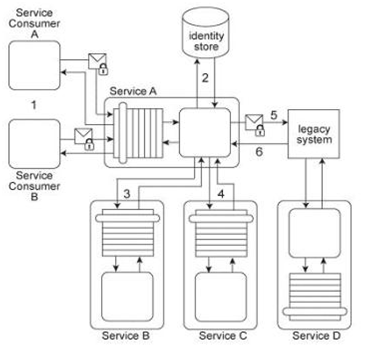Arcitura Education Exam S90.20 Topic 1 Question 14 Discussion
Topic #: 1
Service A has two specific service consumers, Service Consumer A and Service Consumer B (1). Both service consumers are required to provide security credentials in order for Service A to perform authentication using an identity store (2). If a service consumer's request message is successfully authenticated, Service A processes the request by exchanging messages with Service B (3) and then Service C (4). With each of these message exchanges, Service A collects data necessary to perform a query against historical data stored in a proprietary legacy system. Service A's request to the legacy system must be authenticated (5). The legacy system only provides access control using a single account. If the request from Service A is permitted, it will be able to access all of the data stored in the legacy system. If the request is not permitted, none of the data stored in the legacy system can be accessed. Upon successfully retrieving the requested data (6), Service A generates a response message that is sent back to either Service Consumer A or B .The legacy system is also used independently by Service D without requiring any authentication. Furthermore, the legacy system has no auditing feature and therefore cannot record when data access from Service A or Service D occurs. If the legacy system encounters an error when processing a request, it generates descriptive error codes. This service composition architecture needs to be upgraded in order to fulfill the following new security requirements:
1. Service Consumers A and B have different permission levels, and therefore, response messages sent to a service consumer must only contain data for which the service consumer is authorized.
2. All data access requests made to the legacy system must be logged.
3. Services B and C must be provided with the identity of Service A's service consumer in order to provide Service A with the requested data.
4. Response messages generated by Service A cannot contain confidential error information about the legacy system. Which of the following statements provides solutions that satisfy these requirements?

Currently there are no comments in this discussion, be the first to comment!